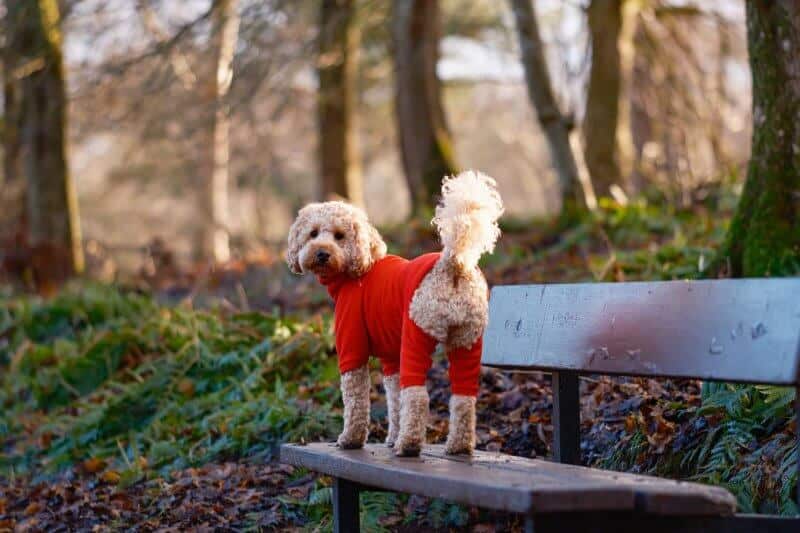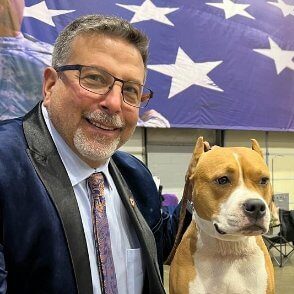I am hoping that the title of this article has befuddled my readers enough to grab their attention and read on. Like many of us in the world of purposefully bred dogs, I spend most of my time contemplating the next show, my competition, my goals, breeding programs, and even camper repairs. However, the most important aspect of our focus, which is not understood by the general public, is canine structure, which determines a dog’s ability to do its job effectively. While there are other factors that play an important part in a judge’s decision, including type, color, and hype, the decision should be weighted on structure.
It is our attention to structure, form, and function that preserves our breeds and sets us apart from the rest of the dog world. However, regardless of our level of focus and attention, we remain woefully misunderstood by a public who is exposed to narratives created by animal rights (AR) groups and has been sold a potentially expensive bill of goods by “hybrid” breeders pushing the possibility of dogs with hypoallergenic coats that have become a popular status piece in certain communities. Yes, I know that I am preaching to the choir, but my real purpose for writing about this topic is to have readers repost on their personal social media feeds where their non-dog people friends will see it and hopefully take some of my message to heart. This is really part of our job as preservation breeders as we continue to take on challenges from the AR organizations.
When the weather is warm and I am not doing dog activities, I enjoy bicycling, and my rides often take me through state and local parks where I get a purview of the local dogs outside of my insular purposefully bred dog world. What I have noticed in my affluent Bucks County, Pennsylvania, suburb is that hybrid breeds, especially “doodles,” outnumber purebred breeds by a great proportion. The sad reality is that doodles have become a designer brand in certain circles.
The general public has no idea about the difference between designer dogs and real purposefully bred purebred dogs, bred by quality show breeders. We have a responsibility, as the shareholders of the dog community, to explain the differences between our dogs and dogs that are bred by FOR PROFIT breeders who lead people down a dangerous path with the promise of a specious level of hypoallergenic coat and breed traits that cannot be predicted within their genetic crap-shoot.
Stating the obvious, quality breeders of purebred dogs engage in genetic testing, trying to eliminate breed-specific problems that are known. My Tibetan Spaniels are tested for retinal problems (pra3 and ppl) and my Amstaffs are genetically screened for ataxia, have OFA for hips and elbows, and undergo cardiac testing. By doing testing, we offer our puppy people the benefit of lower veterinary bills and a happy, healthy canine companion that has a higher probability of a longer life expectancy.
Another area of critical importance that needs to be mentioned is predictability. Knowing what you’re getting is of crucial importance, especially when you are bringing a canine family member into your home. As breeders of purebred dogs, we can easily refer to muti-generational pedigrees that go back at least seven generations. Within the breeds themselves, there are consistent traits that are breed-specific. When undertaking a cross-breeding, predictability flies out the window. Since thirty percent of personality is biologically determined, when breeding two other breeds together (or a series of hybridizations) there is a genetic cascade effect that makes it impossible to determine temperament.
The same goes for the less understood area of structure. Structure refers to a dog’s ability to fulfill its intended purpose. For breeders who show in Conformation dog shows, breeding for structure is the key to competitive success. Each AKC registered dog has a breed “standard’ that discusses how the parts of the dog should fit together and includes key aspects of appearance, color, and movement.
Going back to my title, “Judging the “Dog Park Dog Show,” at over twenty mph on my bicycle I can spot a dog with a poorly structured front or rear and faulty movement, and I get to be entertained by an array of bad temperaments, from the most frightened to the overly aggressive. The scariest thought is that many of these people overpaid for their dogs. Their cross-breeds truly are the result of a “for profit” venture as compared to Conformation breeders who are stakeholders in the preservation of purebred dogs.
“In a recent podcast with Australian NBC News, Wally Conron, a developer of the ALBD stated publicly that he wished he had not created the breed, and that he had “opened a Pandora’s box” and released “a Frankenstein monster,” a comment made in relation to health issues associated with unscrupulous breeding practices [43]. He and others have argued that designer breeding programs have the potential to reveal recessive traits which accentuate latent genetic health issues [12, 15].
“Hybrid vigor” does not always prevail, particularly if parental breeds share common disease causing alleles [44, 45]. Patellar luxation, Von Willebrand blood clotting disease, progressive retinal atrophy, and hip and elbow dysplasia are common health problems for the ALBD. Given the popularity of the breed, these issues should be addressed. Our study demonstrates the overwhelming POOD component of the ALBD, providing a direction for the development of genetic tests to be incorporated into thoughtful breeding programs designed to enhance the attributes of this designer breed.”
And here’s a case study: “Benny the Norgi”
“Benny” is a seven-year-old “Norgi,” the product of a breeding between a Norwich Terrier and a Pembroke Welsh Corgi. He lives in a loving household and is owned by dear friends who afford him a great life that I would want for any of my puppies. Previous to Benny, his owners had two lovely Shih Tzus that lived out long and very healthy lives. From an early age, it became apparent that coat care would be an issue. Benny has a hard topcoat with a soft undercoat, and clipping the dog has netted some rather unusual looks.
Structurally, he is a mix of both breed’s structure; he is longer like the Corgi, but has a head structure like a Norwich. He is longer than tall and appears to have arthritis in his rear vertebrae that correlates to his length. Additionally, he shows signs of dysplasia and has a hard time moving for a dog of his age. When my friend told me he was getting one, I asked why? He retorted that a few of his friends in Florida have them and they are great dogs. I never asked about the associated price tag, but I did ask, “Why not another Shih Tzu?” I really think that he thought it was a cool, en vogue thing to do and was not thinking like a purposefully bred dog breeder.
I am not being critical of my friend’s decision, as we all make decisions based on the knowledge that we have. But I feel bad for Benny who is not structurally sound due to the dumb idea of some “breeder” making a cash-grab and who had no idea what his venture would net or about the animals he would produce.
If you want to hear the worst stories about doodles, ask a professional groomer. I did just that, asking Katie Ceclio, who shows and breeds Bedlington Terriers, about her experiences.
“First of all, they are incredibly popular, including with first-time dog owners. I rarely go more than a day without grooming at least one designer mix. Purebred clients are uncommon, and I can count the number of well-bred purebred dogs that I groom on my hands. The owners are rarely prepared for all the maintenance involved with these dogs, and that isn’t even touching on the rampant behavioral and health issues.
Many owners are willfully, aggressively ignorant, and aren’t fit to own any dog, regardless of breed or mix. Though many people advocate for introducing would-be doodle buyers to breeds similar in appearance and/or desired temperament, I would find responsible breeders better off not selling these kinds of owners anything. That being said, many are still capable of learning the ins and outs of responsible dog ownership, and there are fanciers among us who bought a designer mix and later got well-bred purebred dogs. Though most groomers will say their issue lies with the owners—and that isn’t untrue—so many of these doodles are “born with a screw loose.”
Predispositions to fear and aggression are common, and you just cannot love or train the genetics out of a dog. I personally feel this is not present enough in the discourse around doodles in the industry, and it puts those who don’t know in a dangerous position. Two of the top three worst bites I ever received were from the same Goldendoodle. She was very averse to change and would escalate from warning to level 2-3 bites in the blink of an eye. Her own owners could not do anything to her that she did not want to do. She and I generally had a good rapport, but when I switched to a new grooming job, the change stressed her out so much that I couldn’t even touch her.”
Keep in mind, I wrote this piece to give people in our community some facts in the hopes that we can aid people to make better dog decisions. As a community, we need to be as outspoken as possible, to keep the AR groups out of our world, and to help spread the word about the value of purposefully bred dogs to people who are being indoctrinated by a “rescue dog culture” and the vogue of hybrid dogs that offer ridiculous promises that they cannot deliver.
Having entered the Conformation dog culture in Standard Poodles, I always tell people that if you want a Poodle—GET A POODLE. I often say, when I am done showing dogs and I want a great pet, I will get a Poodle.
Please repost this to your personal feed and join the Dog Show Psychology Facebook Group.
See you in the ring.










